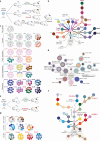Early evolutionary branching across spatial domains predisposes to clonal replacement under chemotherapy in neuroblastoma
- PMID: 39419962
- PMCID: PMC11486966
- DOI: 10.1038/s41467-024-53334-x
Early evolutionary branching across spatial domains predisposes to clonal replacement under chemotherapy in neuroblastoma
Abstract
Neuroblastoma (NB) is one of the most lethal childhood cancers due to its propensity to become treatment resistant. By spatial mapping of subclone geographies before and after chemotherapy across 89 tumor regions from 12 NBs, we find that densely packed territories of closely related subclones present at diagnosis are replaced under effective treatment by islands of distantly related survivor subclones, originating from a different most recent ancestor compared to lineages dominating before treatment. Conversely, in tumors that progressed under treatment, ancestors of subclones dominating later in disease are present already at diagnosis. Chemotherapy treated xenografts and cell culture models replicate these two contrasting scenarios and show branching evolution to be a constant feature of proliferating NB cells. Phylogenies based on whole genome sequencing of 505 individual NB cells indicate that a rich repertoire of parallel subclones emerges already with the first oncogenic mutations and lays the foundation for clonal replacement under treatment.
© 2024. The Author(s).
Conflict of interest statement
D.B. has received research funding from Healx, aPODD foundation, and Captor Therapeutics for unrelated work. The other authors declare no competing interests.
Figures







References
Publication types
MeSH terms
Substances
LinkOut - more resources
Full Text Sources
Medical
Research Materials
Miscellaneous

